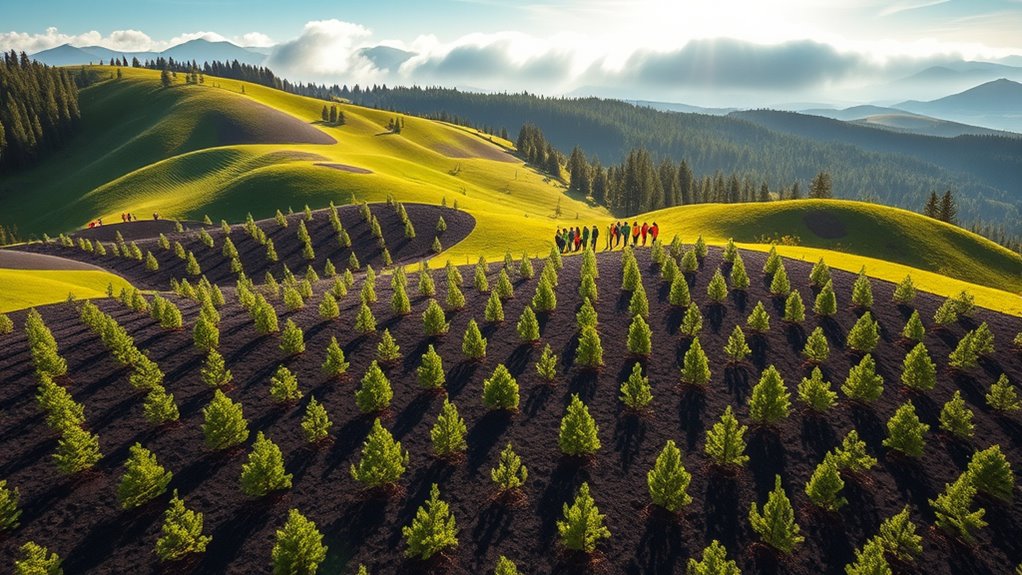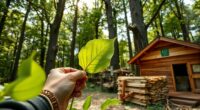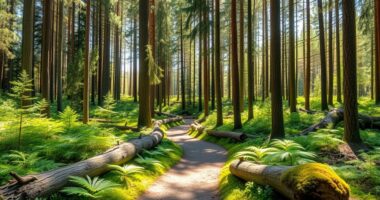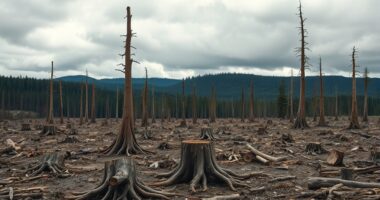In New Zealand, reforestation efforts focus on planting native trees like mānuka and kānuka to restore ecosystems and improve land health. Projects such as the Billion Trees Program and policies like the Emissions Trading System support these goals, while respecting Māori cultural values tied to forests. Despite challenges like limited land and climate impacts, ongoing initiatives aim to enhance biodiversity and combat land degradation. To discover more about these essential efforts, keep exploring how they’re shaping the country’s sustainable future.
Key Takeaways
- New Zealand’s Billion Trees Program aims to plant 1 billion native and exotic trees by 2028 to restore ecosystems and combat land degradation.
- Reforestation projects incorporate indigenous Māori values, respecting spiritual connections, tapu, and the role of forests as ancestral kin.
- Government policies like the Emissions Trading System incentivize forest growth through carbon credits, supporting sustainable forestry initiatives.
- Ecological principles and geometric planning optimize planting layouts, enhance resilience, and ensure environmental and visual impact considerations.
- Challenges include limited land availability, climate change effects, poor soil quality, and high costs, requiring integrated strategies for effective reforestation.
Examples of Reforestation Projects in New Zealand

New Zealand has launched several notable reforestation projects to restore its native ecosystems and combat land degradation. These reforestation projects focus on planting native trees to increase forest cover and support biodiversity. The Billion Trees Program aims to plant one billion native and exotic trees by 2028, addressing erosion and climate change. The “Retiring Farmland into Ngahere” project uses the Tīmata Method, reducing native reforestation costs across about 1 million hectares of erodible land. You might also see efforts like the Pikirangi forest, planted with native species such as mānuka and kānuka, which continue to regenerate naturally. These projects not only restore land but also generate carbon credits, influencing land use policies and promoting sustainable forestry practices nationwide. Geometric principles are often applied to optimize planting layouts and ensure the structural integrity of reforested areas. Additionally, understanding coastal zone dynamics helps in planning reforestation near vulnerable landforms to prevent erosion and enhance natural barriers. Incorporating ecological principles into planning ensures that the reforestation efforts support resilient and self-sustaining ecosystems. Moreover, contrast ratio considerations can be useful when selecting sites for reforestation to evaluate the visual and environmental impact effectively. To maximize success, air quality considerations are increasingly integrated into planning to ensure that reforested areas contribute to improved local air conditions and overall ecosystem health.
Indigenous Perspectives and Cultural Significance
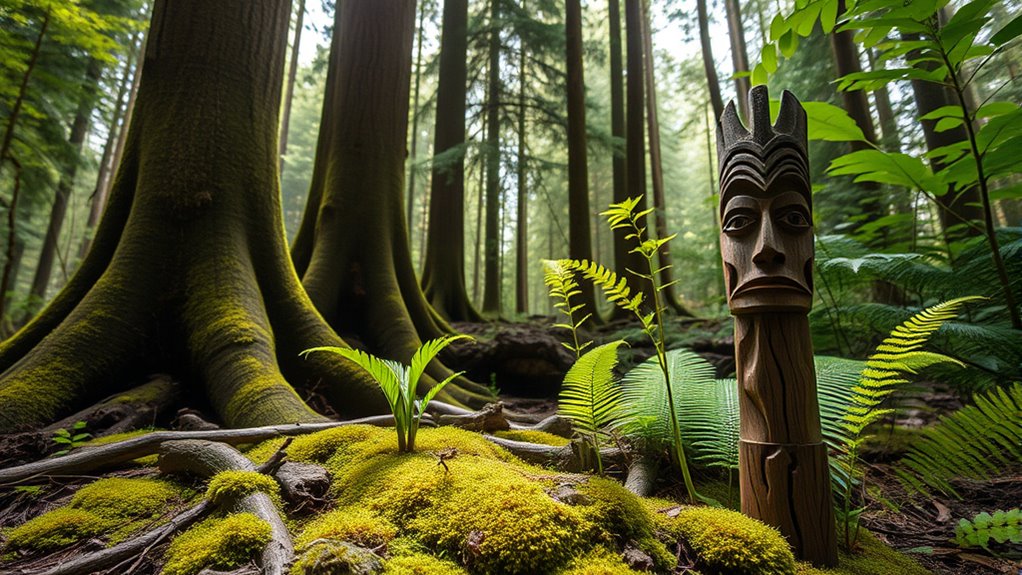
Have you ever considered how indigenous Māori perspectives shape the way forests are valued and cared for in New Zealand? Māori see forests as sacred, intertwined with ancestry and spiritual life. Tāne, the atua of trees, connects the natural and spiritual worlds, highlighting interdependence. Respecting tapu, or sacredness, involves rituals and prayer before felling a tree, honoring its mauri—its life force. Māori regard forests as tūpuna (ancestors) and kin, emphasizing a duty to protect and preserve their sacredness for future generations. This cultural view fosters a deep spiritual connection and ecological responsibility. The table below summarizes key Māori values related to forests:
| Value | Meaning | Practice |
|---|---|---|
| Tapu | Sacredness | Rituals before harvesting |
| Mauri | Life force | Respecting natural entities |
| Interdependence | Mutual reliance | Caring for forests as kin |
Government Policies Supporting Forest Restoration
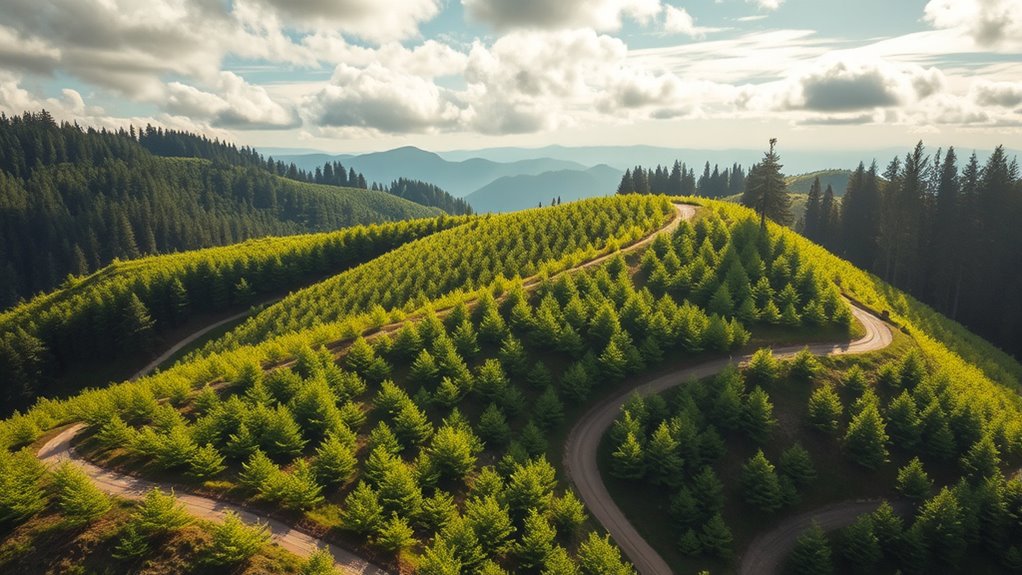
Māori perspectives on sacred forests and spiritual responsibility align with the New Zealand government’s efforts to restore native ecosystems. Through policies like the One Billion Trees Program, you’re helping to boost reforestation with native trees, supporting biodiversity and cultural values. The government’s Emissions Trading System (ETS) enables forest owners to generate and sell carbon credits, incentivizing forest growth and reducing emissions. The National Policy Statement for Indigenous Biodiversity encourages the restoration and connectivity of native ecosystems across the country. Funding schemes like the Regional Afforestation Scheme provide financial support for planting on erosion-prone lands. Active agencies such as the Department of Conservation and the Ministry for Primary Industries promote and facilitate these initiatives, ensuring that reforestation aligns with ecological and cultural priorities.
Challenges Facing Reforestation in Aotearoa

What are the main obstacles hindering reforestation efforts in Aotearoa? Land availability is limited due to competing uses like agriculture, urban growth, and forestry. Climate change worsens this challenge by causing altered rainfall, higher temperatures, and more droughts, risking native forest survival. Poor soil quality from past land uses complicates establishing healthy native trees. Supporting biodiversity hotspots and maintaining healthy ecosystems are crucial for native forest resilience. Additionally, the costs associated with soil restoration can be prohibitive for many projects. Funding is another hurdle; planting, maintenance, and pest control require significant resources. Policy restrictions and community opposition can also slow progress. To better understand, consider this table:
| Challenge | Impact |
|---|---|
| Limited land | Restricts large-scale reforestation efforts |
| Climate change | Threatens forest growth and survival |
| Soil quality | Hinders native tree establishment |
| Funding and resources | Essential for ongoing maintenance and pests |
| Policy and community | Can impede or delay reforestation initiatives |
Addressing land management practices is essential for creating more opportunities for reforestation in the future. Moreover, understanding the role of attention in planning and executing reforestation projects can significantly influence their success, as focused efforts often lead to more innovative solutions.
How to Contribute to Reforestation Initiatives
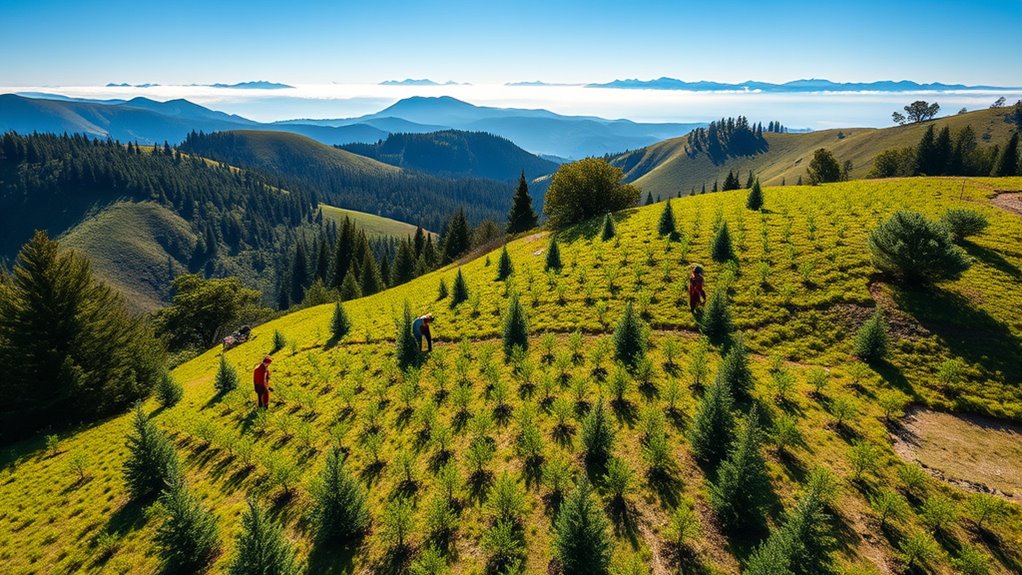
You can play a vital role in supporting reforestation efforts by getting involved with organizations like Trees That Count or Conservation Volunteers NZ, which fund native tree planting projects. To contribute, consider these actions:
- Support native reforestation by donating or participating in volunteer planting days, helping restore native forests.
- Advocate for conservation policies that prioritize reforestation and sustainable land management, ensuring stronger government and private sector support.
- Educate others about the importance of native tree species for biodiversity, climate change mitigation, and cultural values.
- Practice eco-friendly land management if you own land, like planting native species and reducing land clearance. Your efforts can greatly enhance biodiversity and resilience.
- Use sustainable forestry practices when sourcing materials or managing land to promote renewable resources and reduce environmental impact.
Frequently Asked Questions
What Is New Zealand Doing to Stop Deforestation?
You see that New Zealand is actively fighting deforestation through various initiatives. The government’s One Billion Trees Program encourages planting native and exotic trees, while policies like the Indigenous Biodiversity Statement focus on protecting native forests. Conservation projects, funding schemes, and Māori-led efforts also play vital roles, restoring ecosystems and safeguarding biodiversity. These combined efforts show a strong commitment to stopping deforestation and promoting sustainable forest management across the country.
Which Country Has the Highest Rate of Reforestation?
Imagine a nation quietly rewriting its green story—China leads the charge in reforestation worldwide. You should know that China’s massive efforts, like the Natural Forest Preservation Program, have transformed barren lands into lush forests, increasing coverage from less than 12% in the 1980s to over 23% in 2020. These bold steps aim to fight desertification, soil erosion, and restore biodiversity, making China the top reforester on the global stage.
What Is the New Zealand Tree Planting Scheme?
You’re asking about the New Zealand Tree Planting Scheme. This initiative aims to plant one billion trees by 2028, helping combat climate change and restore ecosystems. You can get involved through government programs and community efforts. The scheme supports native and exotic trees, focusing on erodible and degraded lands, especially in areas like Hawke’s Bay. It also uses innovative methods like the Tīmata Method to make reforestation more affordable and effective.
What Is the Largest Reforestation Project in the World?
You might be surprised to learn that China’s Grain for Green program is the world’s largest reforestation project, transforming over 23 million hectares of farmland into forests since 1999. This massive effort involves paying farmers to plant native trees, helping to fight soil erosion, desertification, and biodiversity loss. By 2020, China’s forest coverage doubled from under 12% in the 1980s to about 23%, showcasing a powerful commitment to ecological restoration.
Conclusion
Reforestation in New Zealand is like planting hope in a fragile garden. Your support and awareness can help nurture these efforts, ensuring the land’s future blossoms with vibrant forests and cultural richness. By participating, whether through volunteering, advocating, or simply spreading the word, you become part of this essential renewal. Together, you can turn the tide and help restore Aotearoa’s natural beauty, one tree at a time.
